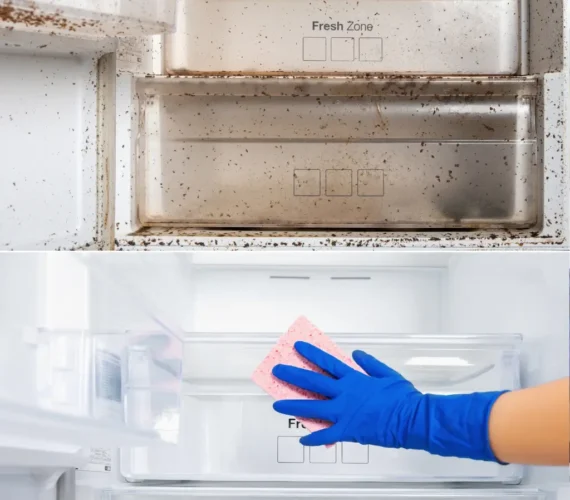
Refrigerator Cleaning: A Complete Guide to a Sparkling, Germ-Free Fridge
Keeping your refrigerator clean is essential for food safety, extending the life of your appliance, and maintaining a fresh-smelling kitchen. While it may seem like a daunting task, cleaning your fridge can be straightforward with the right approach. In this guide, you’ll find step-by-step instructions, helpful tips, and eco-friendly cleaning methods to make your refrigerator cleaning experience efficient and effective.
Why Regular Refrigerator Cleaning Is Important
- Food Safety and Hygiene
A clean refrigerator prevents the growth of bacteria, mold, and unpleasant odors. Leftover spills or expired items can contaminate fresh food, posing health risks. - Energy Efficiency
A dirty refrigerator can become less efficient. Dust and grime on coils, along with blocked vents, force the appliance to work harder, increasing energy consumption. - Prolongs Appliance Life
Regular maintenance reduces wear and tear, extending the life of your refrigerator and avoiding costly repairs or early replacement.
How Often Should You Clean Your Refrigerator?
- Weekly: Do a quick check to remove expired food and wipe down visible spills.
- Monthly: Perform a more thorough clean, wiping shelves, drawers, and seals.
- Seasonally (Every 3-4 Months): Deep clean the entire appliance, including the coils, interior, and gasket seals.
Tools and Supplies Needed for Refrigerator Cleaning
- Mild dish soap or eco-friendly cleaner
- Baking soda and white vinegar (for natural cleaning)
- Microfiber cloths or sponges
- Soft-bristled brush or old toothbrush
- Bucket of warm water
- Vacuum with a brush attachment (for coils)
- Trash bag for expired items
Step-by-Step Refrigerator Cleaning Process
1. Turn Off the Refrigerator
Before starting, unplug the refrigerator to conserve energy and ensure safety. If this isn’t possible, adjust the temperature to the lowest setting.
2. Empty the Refrigerator
- Remove all food items. Check for expired or spoiled food and discard it.
- Store perishable items in a cooler or insulated bag during the cleaning process.
3. Take Out Shelves and Drawers
- Remove shelves, drawers and any detachable compartments.
- Soak them in warm, soapy water to loosen grime and stains.
4. Clean the Interior
- Mix a solution of warm water and mild dish soap or use a natural mix of vinegar and water (1:1 ratio).
- Use a sponge or microfiber cloth to wipe down walls, ceilings, and corners.
- Pay extra attention to spills and sticky spots, scrubbing gently.
5. Address Tough Stains and Odors
- For stubborn stains: Make a paste of baking soda and water, apply to the stain, let sit for 10 minutes, then scrub gently.
- For odors: Place an open box of baking soda or a small dish of coffee grounds in the fridge to absorb lingering smells.
6. Clean Shelves and Drawers
- Rinse and dry the soaked shelves and drawers thoroughly.
- Wipe down with a clean towel to ensure they are spotless before returning them.
7. Clean the Door Seals (Gasket)
- Use a soft-bristled brush dipped in soapy water to scrub the rubber seals.
- Ensure no food particles or mold are hiding in the crevices.
8. Wipe Down the Exterior
- Clean the exterior with a microfiber cloth and mild soap.
- For stainless steel, use a specialized cleaner or a vinegar-water mix for a streak-free finish.
9. Vacuum the Coils
- Locate the coils (usually at the back or bottom of the refrigerator).
- Use a vacuum with a brush attachment to remove dust and debris, improving energy efficiency.
10. Reassemble and Restock
- Reinsert clean shelves and drawers.
- Wipe down food containers before placing them back.
- Plug in the refrigerator and set it to the correct temperature (below 40°F/4°C).
Eco-Friendly Refrigerator Cleaning Tips
- Use Natural Cleaners
Avoid harsh chemicals by using vinegar, baking soda, or lemon juice for effective, eco-friendly cleaning. - Minimize Waste
Instead of paper towels, use reusable cloths or old t-shirts. - Compost Expired Produce
If possible, compost spoiled fruits and vegetables instead of throwing them away.
Preventive Maintenance Tips for a Clean Refrigerator
- Cover Food and Drinks: Prevent spills by storing items in sealed containers or with covers.
- Use Fridge Mats: Place washable mats on shelves to catch spills and crumbs.
- Keep Baking Soda Inside: Maintain a fresh-smelling fridge by leaving an open box of baking soda inside.
- Organize by Expiry Date: Place older items in front to avoid forgetting about them and reduce waste.
Conclusion
A clean refrigerator is more than just a visually appealing appliance—it ensures food safety, boosts efficiency, and prolongs the life of your fridge. By following these simple steps and incorporating regular maintenance, you can keep your refrigerator spotless and fresh year-round. Make refrigerator cleaning a habit, and enjoy the benefits of a hygienic and efficient kitchen appliance.
